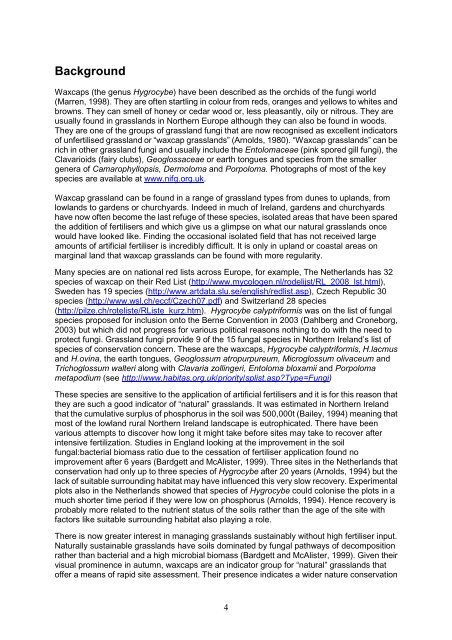North Kerry Waxcap Survey 2012 - the Northern Ireland Fungus Group
North Kerry Waxcap Survey 2012 - the Northern Ireland Fungus Group
North Kerry Waxcap Survey 2012 - the Northern Ireland Fungus Group
You also want an ePaper? Increase the reach of your titles
YUMPU automatically turns print PDFs into web optimized ePapers that Google loves.
Background<br />
<strong>Waxcap</strong>s (<strong>the</strong> genus Hygrocybe) have been described as <strong>the</strong> orchids of <strong>the</strong> fungi world<br />
(Marren, 1998). They are often startling in colour from reds, oranges and yellows to whites and<br />
browns. They can smell of honey or cedar wood or, less pleasantly, oily or nitrous. They are<br />
usually found in grasslands in <strong>North</strong>ern Europe although <strong>the</strong>y can also be found in woods.<br />
They are one of <strong>the</strong> groups of grassland fungi that are now recognised as excellent indicators<br />
of unfertilised grassland or “waxcap grasslands” (Arnolds, 1980). “<strong>Waxcap</strong> grasslands” can be<br />
rich in o<strong>the</strong>r grassland fungi and usually include <strong>the</strong> Entolomaceae (pink spored gill fungi), <strong>the</strong><br />
Clavarioids (fairy clubs), Geoglossaceae or earth tongues and species from <strong>the</strong> smaller<br />
genera of Camarophyllopsis, Dermoloma and Porpoloma. Photographs of most of <strong>the</strong> key<br />
species are available at www.nifg.org.uk.<br />
<strong>Waxcap</strong> grassland can be found in a range of grassland types from dunes to uplands, from<br />
lowlands to gardens or churchyards. Indeed in much of <strong>Ireland</strong>, gardens and churchyards<br />
have now often become <strong>the</strong> last refuge of <strong>the</strong>se species, isolated areas that have been spared<br />
<strong>the</strong> addition of fertilisers and which give us a glimpse on what our natural grasslands once<br />
would have looked like. Finding <strong>the</strong> occasional isolated field that has not received large<br />
amounts of artificial fertiliser is incredibly difficult. It is only in upland or coastal areas on<br />
marginal land that waxcap grasslands can be found with more regularity.<br />
Many species are on national red lists across Europe, for example, The Ne<strong>the</strong>rlands has 32<br />
species of waxcap on <strong>the</strong>ir Red List (http://www.mycologen.nl/rodelijst/RL_2008_lst.html),<br />
Sweden has 19 species (http://www.artdata.slu.se/english/redlist.asp), Czech Republic 30<br />
species (http://www.wsl.ch/eccf/Czech07.pdf) and Switzerland 28 species<br />
(http://pilze.ch/roteliste/RListe_kurz.htm). Hygrocybe calyptriformis was on <strong>the</strong> list of fungal<br />
species proposed for inclusion onto <strong>the</strong> Berne Convention in 2003 (Dahlberg and Croneborg,<br />
2003) but which did not progress for various political reasons nothing to do with <strong>the</strong> need to<br />
protect fungi. Grassland fungi provide 9 of <strong>the</strong> 15 fungal species in <strong>North</strong>ern <strong>Ireland</strong>’s list of<br />
species of conservation concern. These are <strong>the</strong> waxcaps, Hygrocybe calyptriformis, H.lacmus<br />
and H.ovina, <strong>the</strong> earth tongues, Geoglossum atropurpureum, Microglossum olivaceum and<br />
Trichoglossum walteri along with Clavaria zollingeri, Entoloma bloxamii and Porpoloma<br />
metapodium (see http://www.habitas.org.uk/priority/splist.asp?Type=Fungi)<br />
These species are sensitive to <strong>the</strong> application of artificial fertilisers and it is for this reason that<br />
<strong>the</strong>y are such a good indicator of “natural” grasslands. It was estimated in <strong>North</strong>ern <strong>Ireland</strong><br />
that <strong>the</strong> cumulative surplus of phosphorus in <strong>the</strong> soil was 500,000t (Bailey, 1994) meaning that<br />
most of <strong>the</strong> lowland rural <strong>North</strong>ern <strong>Ireland</strong> landscape is eutrophicated. There have been<br />
various attempts to discover how long it might take before sites may take to recover after<br />
intensive fertilization. Studies in England looking at <strong>the</strong> improvement in <strong>the</strong> soil<br />
fungal:bacterial biomass ratio due to <strong>the</strong> cessation of fertiliser application found no<br />
improvement after 6 years (Bardgett and McAlister, 1999). Three sites in <strong>the</strong> Ne<strong>the</strong>rlands that<br />
conservation had only up to three species of Hygrocybe after 20 years (Arnolds, 1994) but <strong>the</strong><br />
lack of suitable surrounding habitat may have influenced this very slow recovery. Experimental<br />
plots also in <strong>the</strong> Ne<strong>the</strong>rlands showed that species of Hygrocybe could colonise <strong>the</strong> plots in a<br />
much shorter time period if <strong>the</strong>y were low on phosphorus (Arnolds, 1994). Hence recovery is<br />
probably more related to <strong>the</strong> nutrient status of <strong>the</strong> soils ra<strong>the</strong>r than <strong>the</strong> age of <strong>the</strong> site with<br />
factors like suitable surrounding habitat also playing a role.<br />
There is now greater interest in managing grasslands sustainably without high fertiliser input.<br />
Naturally sustainable grasslands have soils dominated by fungal pathways of decomposition<br />
ra<strong>the</strong>r than bacterial and a high microbial biomass (Bardgett and McAlister, 1999). Given <strong>the</strong>ir<br />
visual prominence in autumn, waxcaps are an indicator group for “natural” grasslands that<br />
offer a means of rapid site assessment. Their presence indicates a wider nature conservation<br />
4


